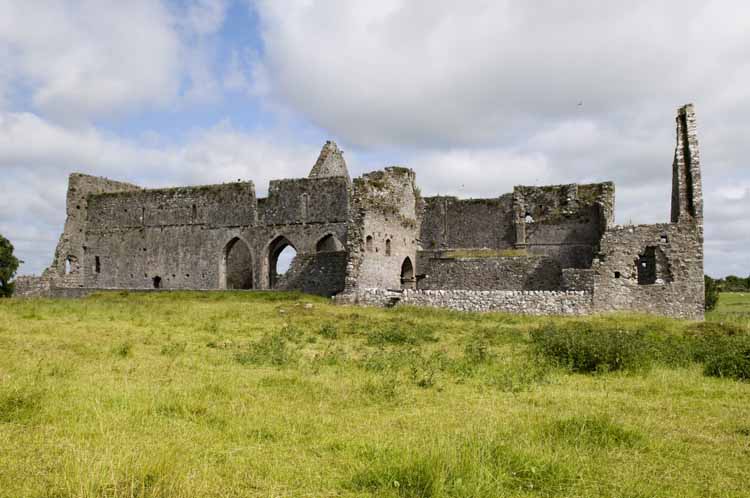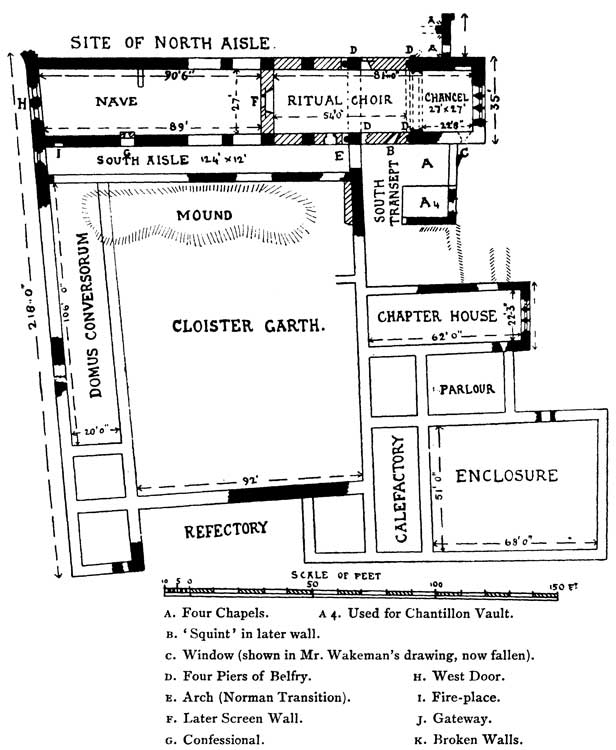The Cistercian Abbey of Monasteranenagh (Manister), County Limerick, Ireland,
was founded in 1148 by Turlough O’Brien, King of Thomond. Donal Mor
O’Brien became patron of the abbey after Turlogh’s death. It was a
daughter house of Mellifont and subsequently established three daughter
houses (Abbeydorney, Midleton and Holycross). Its name derived from
‘Manister an Aonaigh’, the monastery of the fair, after a fair that was
held at the site in ancient times. Its Latin name represents the
latinisation of the local river: ‘Magium’, from the river Mague. The
Abbey complex was built a little way from the river, on a section of
slightly raised ground, which avoid flooding - the site is very
flat. The abbey was heavily involved in the ‘conspiracy of
Mellifont’ and in 1227 affiliation of the abbey was transferred to
Margam in Wales. In the following year the Irish monks forced the abbot
and the non-Irish monks, who were mainly of Norman descent, to leave the
abbey. The remaining monks attempted to prevent Stephen of Lexington
from visiting the abbey by fortifying the precinct; they prepared the
abbey for siege, turning it into a castle and building a tower above the
altar. The ring leader was the King of Thomond, who resented the
presence of the Anglo-Normans in Ireland. The community was
excommunicated for revolting against their ecclesiastical superiors.
Herbert de Burgo, the bishop of Limerick, eventually recaptured the
abbey and reinstalled the monks who had been driven out; the rebellious
monks returned and asked for mercy which was granted. By the end of the
13th century the abbey was in debt for £209, a fortune, to an Italian
wool merchant, Ricardi de Lucca.
The abbey was suppressed in 1539-40, and the property
was granted to Sir Osborne Echingham in 1543. However, the monks were
left in possession of the abbey (it was outside of Anglo control which
had shrunk to within the 'Pale') which they retained until 1580. Some of
the monks who were expelled from affiliated abbeys in 1540-2 are said to
have joined the community at Monasteranenagh. It was the scene of a
major battle during the Geraldine rebellion of 1579-1580 and in 1579 Sir
William Malby led the English into battle against the Irish and the
Spanish. The Irish army, led by Sir John of Desmond, was defeated and
the Spanish and Irish troops took refuge in the abbey. The English army
turned its guns on the abbey and captured it; the abbot was reputed to
have been beheaded on the altar steps and that forty monks were slain
within the precinct. The abbey was burned and the Cistercian
community at Monasteranenagh ended. The buildings were further damaged
in 1585 when it became the property of Sir Henry Wallop who plundered
the abbey of all its valuables and left the ruins to decay.
Today, the ruins mainly include the church, which dates from
1170 to 1220, and an early Gothic chapter house. The walls,
gables and the main window frame of the church are all extant. The tower
fell in 1806-7; it was thought to have been either the crossing tower of
the church or part of a 16th century house that was constructed
over the south transept. The transepts held three chapels each which had
groin or ribbed vaults and the presbytery had a barrel vault (which
collapsed in 1874) and a crossing tower was added at some stage and
later the complexes overall design was reduced in size. The interior of the abbey was used as a burial
ground until the 1970s. A short distance from the abbey is another set
of ruins which appears to be the remains of the old guesthouse. The
ruins are situated on a flat plain, ten miles south of Limerick, and can
be accessed by the public at all times (except when the fields are full
of cattle).
Plan of the Abbey (Westropp, 1889): Sources:


Stalley, R. 1987. The Cistercian Monasteries of Ireland, London: Yale
University Press.
University of Sheffield - The Cistercians in Yorkshire Project
Westropp, t. 1889. History of the Abbey and Battles of
Monasteranenagh, Croom, County Limerick, 1148-1603, The Journal of the
Royal Historical and Archaeological Association of Ireland, Vol. 9 (80),
232-238.